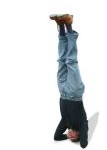 By Narendra Maheshri
By Narendra Maheshri
The Salamba Sirsasana, or Headstand, is one of the poses most widely identified with yoga practice. Many practitioners view it as a pose that, while difficult, should be aspired to because of the mental and physical benefits it espouses. Many raw beginners worry that the pose is too advanced for them to master easily, and yet mastering several poses like Mountain Pose, Downward Facing Dog, and Shoulder stand can help prepare yogis for the shoulder lift and inversion of the more difficult Headstand.
The Pros of Sirsasana (Headstand)
Headstand is a pose that practiced yogis can get a lot out of. As a more advanced pose, it requires strength and mobility and, most of all, extreme focus. So even in working up to performing the Headstand, practitioners acquire increased flexibility and toning of the shoulders, neck, and spine. A tighter core and strong inner focus are also important in correctly performing this pose.
Once yoga practitioners have successfully made it into a well-aligned Headstand, the next challenge is one, which increases focus and relaxation- holding the pose. Maintaining Salamba Sirsasana for several minutes is one of the best ways to experience some of the benefits it offers.
For example, the pituitary gland is stimulated whenever a person is upside down. Since the pituitary gland aids in digestion and regulates hormones, the Head stand pose can even offer relief to some suffering from digestive problems like irritable bowel syndrome.
Similarly, being upside down increases blood flow to both the brain and the face. As a result, the Headstand both soothes and calms the brain and provides better circulation to the face, which can relieve some skin problems.
The Cons of Sirsasana
The Headstand is one of the poses most widely cited as the cause of injuries in yoga. While neck and back injuries can occur when the pose is performed incorrectly, or even when the practitioner is tired or has lost focus, these injuries are not the only dangers.
According to William Broad, author of The Science of Yoga: The Risks and the Rewards, Salamba Sirsasana is one of the most risky poses yoga offers. He notes that any pose like Headstand, which can torque the neck, can tear arterial linings, causing blood clots and, ultimately, strokes.
Due to the inherent risks of any inversion, yoga practitioners should not rush pose mastery simply to begin doing the Headstand. Instead, yogis should patiently learn each pose with care and focus, taking weeks or months to master the necessary components of Headstand before putting those components together. If you are an older student with medical complications that prohibit inversions, you might already know the potential hazards of inversions for you. If not, please consult your physician before considering inversions.
Ultimately, Headstand offers profound mental and physical benefits, but the risks may cause some to avoid this particular yoga pose altogether. If you are young, healthy, and have no medical conditions, it can’t hurt to get your physician’s approval and guidance from a qualified teacher before working on deep inversions. Much like a ski resort, there is a logical reason why beginner trails exist. It is wise to be patient, do your research, and spend some time learning foundational knowledge with the guidance of a competent teacher.
© Copyright – Aura Wellness Center – Publications Division
To see our selection of Yoga teacher training courses, please visit the following link.
https://aurawellnesscenter.com/store/
Click here too see our online Yoga Nidra teacher training course.
Are you an experienced teacher looking for YACEP credits or continuing education?
Subscribe to Our Newsletter for Special Discounts and New Products
Related Resources
52 Essential Principles of Yoga Philosophy to Deepen your Practice
by Rina Jakubowicz.
A Relaxing Way to De-stress, Re-energize, and Find Balance
by: Gail Boorstein Grossman.
YOGA: THE PATH TO HOLISTIC HEALTH
by B.K.S. Iyengar
TEACHING YOGA: Essential Foundations and Techniques
By Mark Stephens
The Problem With Yoga Inversions and Spinal Compression
Glaucoma and Yoga: What Is Safe?

Headstand is a risky yoga posture but its offers profound mental and physical benefits, Thanks for this nice article!